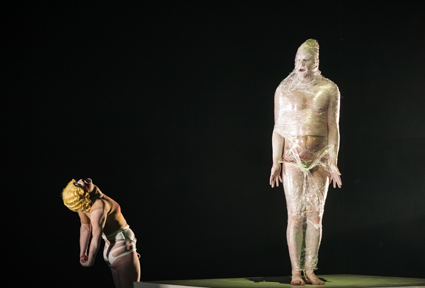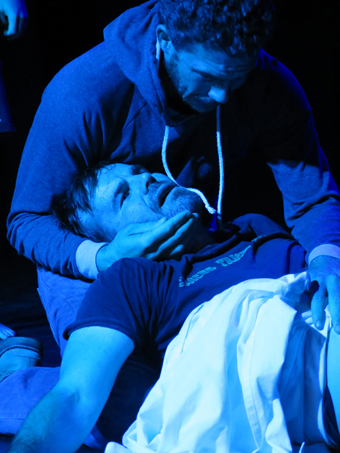Bloody history lessons
Kathryn Kelly: The Danger Ensemble, Caligula; Linda Hassall, The Return

Nerida Matthaei, Stephen Quinn, Caligula, The Danger Ensemble
photo Dylan Evans
Nerida Matthaei, Stephen Quinn, Caligula, The Danger Ensemble
Although widely divergent in form and intention, both The Danger Ensemble’s new show Caligula and Linda Hassall’s verbatim piece about Australian war veterans, The Return, grapple with the brutal impacts of the end of empire: cultural spasm and futile wars.
Brisbane wunderkind Steven Mitchell-Wright opened Caligula with a thrumming soundscape, blinding lights that shimmered and warped and a back wall of performers wearing white paint. Not solemn Butoh bodies, but carnie cut-outs, with the heads and limbs of the performers poking out of plaster-cast statues of their naked bodies. The soundscape peaked and the statues lifted, suspended for the duration of the show, while the lights dimmed to reveal a signature Danger Ensemble mod-pop white set, re-worked into a gallery catwalk formation.
A clowning routine that relays a potted biography of Caligula is followed by 20 or so vignettes: monologues, dance sequences, improvised games, pop songs and further routines exploring the narcissistic and decadent excesses of Caligula’s Rome and our own contemporary culture’s obsession with sex and power through fetish, consumerism, pop culture and violence.
The costumes by Wright and fashion designer Natalie Ryner were so fashion forward they had my teeth grinding in envy. There were dozens of costume changes and the mash of Roman and contemporary fetish references held the show’s loose format together, providing the dramaturgical ballast needed to navigate the show’s piecing together of late twentieth century cultural references (Nick Cave, the Smiths, Camus and Charles Manson) and material drawn from Roman history.
The coup de théâtre was certainly the revelation part-way through the show that the perimeter inside the catwalk was full of thousands of transparent plastic cups that squashed and squeaked as the performers waded in and out, danced across and through them and in one of the show’s truly eerie moments provided a rubbish dump for the corpse of a skinned horse.

The Return
courtesy the artists
The Return
There were moments of intense theatrical pleasure: Brisbane feminist rock idol Lucinda Shaw as a bare-breasted Jesus with a headdress of bloody syringes singing Nick Cave; Chris Beckey as the sinuous Caligula asking plaintively if he would be remembered; an ecstatic monologue by a pizza delivery boy declaiming the joys of fisting. But when you expect the edge it takes a lot to deliver it and many of the ensemble’s set-pieces by now are familiar: the white set, the canny pop song re-delivered, the lofty balcony commentary with its cryptic mash of existential and canonical texts.
“Certainly not History” was the show’s tagline but the collation of canonical material had none of the dexterity evident in the manipulation of the visual iconography. In the most ironic of twists, this made the show feel like a history lesson—a beautifully designed, postmodern history lesson but one no less bossy in its earnest desire to draw parallels between the cultural and political excesses of Caligula’s Rome and our own polyglot, bloody and narcissist contemporary culture.
Indeed, bloody was the experience of watching The Return (presented by artists and researchers from Griffith University), which like Daniel Keene’s The Long Way Home (RT 119, p31) for the Sydney Theatre Company and Australian Defence Force, was performed by veterans as well as professional actors. The raw power of Hassall’s uncompromising aesthetic gave the work, at its best, a sort of herculean credibility and affect. A returned solider tells the story of a bomb attack where his best friend was killed and he carried his sergeant’s brains on his body across the long, despairing day as they sought medical aid. A mother tells us she considers her son’s suicide a combat injury, the wound just took longer to kill.
The show draws power from its long development process with the veterans, independent from the ADF—included are didactic sequences about the compromised role of the ADF in veteran support. However, The Return suffers from its outrage, with long, relentless sequences where the set is endlessly built and rebuilt and much of the non-verbatim material feels dogged and one-dimensional.
Indeed, since the Vietnam War Australians have tried to separate personal politics from the structural violence endured by soldiers. But somehow a piece about the impact of war without an analysis of why we went to war is too easy. Dangerous works point the finger back at us for our role in putting the men and women who patrol the walls of our imaginary empires in harm’s way.
Judith Wright Centre: The Danger Ensemble, Caligula, director, designer Steven Mitchell Wright, designers: Benjamin Hughes and Natalie Ryner, JWC Performance Space, 3-12 July; The Return, writer, director Linda Hassall, design Fiona McKeon, producer Michael Balfour, Professor, Applied Theatre, Griffith University; BEMAC Theatre, Queensland Multicultural Centre, Brisbane, 25, 26 June
RealTime issue #122 Aug-Sept 2014 pg. 44






